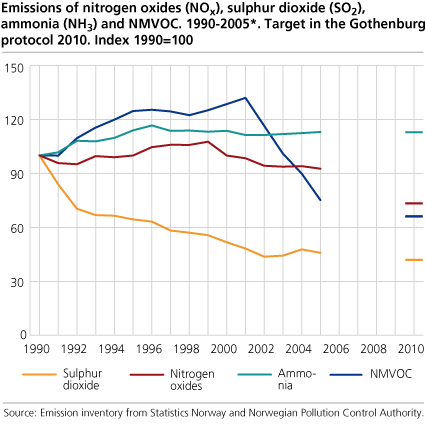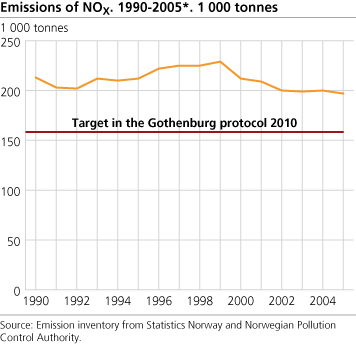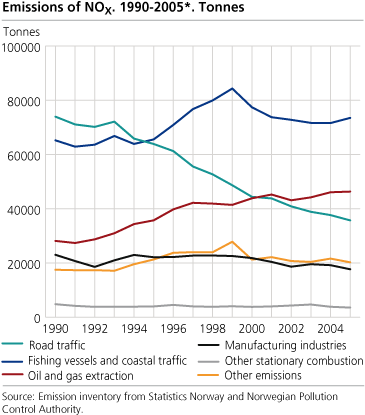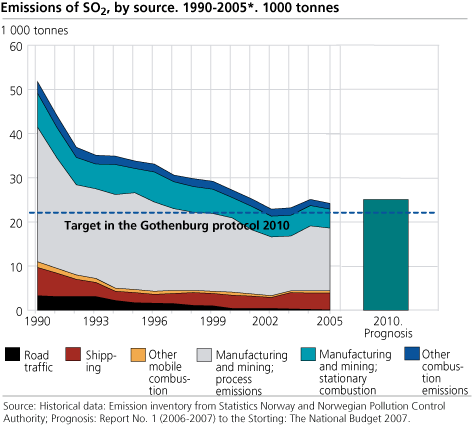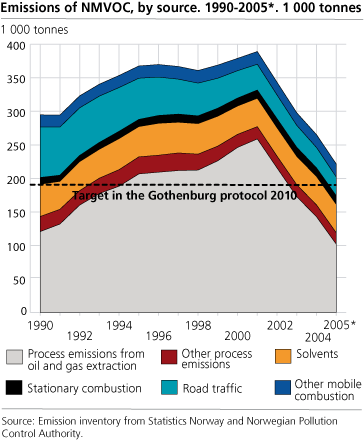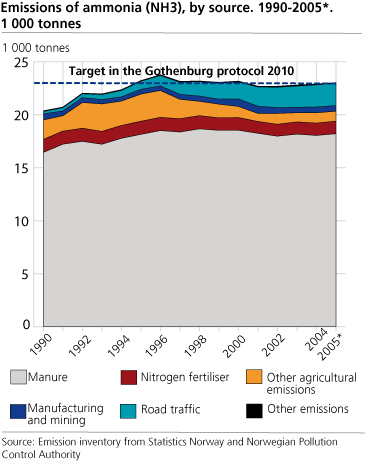Content
Published:
This is an archived release.
21 per cent cut in NOX emissions required by 2010
Since 1990, Norwegian emissions of NO X have been reduced by 7 per cent. However, by 2010 emissions must be cut by a further 21 per cent, or about 41 000 tonnes, in order to reach the NO X emission ceiling set in the Gothenburg Protocol. The required cut roughly corresponds to the emissions from all Norwegian oil and gas activities.
These are some of the results of calculations carried out by Statistics Norway and the Norwegian Pollution Control Authority. The emission figures for NO x have been adjusted down considerably compared to previous publications, due to methodological improvements. As a result, Norway is closer to the emission ceiling set in the Gothenburg Protocol (see box below).
In 2005, Norwegian emissions of nitrogen oxides (NO X ) totalled 197 000 tonnes, a decline of 1.5 per cent compared with 2004. Even though this also represents a 7 per cent decrease since 1990, emissions must be cut by a further 21 per cent, or 41 000 tonnes, in order for Norway to fulfil its commitment under the Gothenburg Protocol and keep emissions below 156 000 tonnes by 2010. The required cut almost equals the total emissions from Norway's oil and gas activities (46 000 tonnes).
Domestic shipping and fishing, oil and gas activities and road traffic were together responsible for nearly 80 per cent of NO x emissions in 2005. The remainder was mainly caused by the use of oil for heating purposes and other combustion, air traffic and the use of motorized equipment. Domestic sea transport and fishing was the largest source of NO X emissions in 2005 and contributed to 37 per cent of the total (73 000 tonnes). The emissions from this source have risen considerably since 1990 and are now 13 per cent above the level of emissions in 1990. Of the remaining 73 000 tonnes, 23 000 tonnes were emitted from fishing vessels, the rest from coastal traffic, ferries, high-speed crafts, supply ships, mobile oil rigs etc.
Oil and gas activities accounted for 46 000 tonnes, or 24 per cent of the NO x emissions in 2005. As is the case for domestic shipping and fishing, oil and gas activity is an important source of NO x emissions for two reasons: Not only are emissions large, but they have also risen considerably since 1990. Emissions from oil and gas activities have increased by 65 per cent during the period 1990-2005.
Still, not all NO x emissions show an upward trend. Even though Norwegian passenger cars cover more kilometres than ever, the emissions of NO X have been cut by half since 1990. The main reason for this decline is that the use of catalytic converters was made mandatory in petrol-powered vehicles in 1989 and subsequent stricter regulations. As a result, emissions of NO x have gradually declined. In 2005, road traffic accounted for 36 000 tonnes, or 18 per cent of total NO x emissions. Emissions from heavy diesel-powered vehicles have also declined following the adoption of emission regulations from such sources in 1993.
Tax on NO X introduced in January 2007 In autumn 2006, the Norwegian Parliament passed a proposal for a tax on emissions of NO X , taking effect on 1 January 2007. The tax of NOK 15 per kilo of NO X emitted applies to i.a. energy production from propulsion engines with a total engine rating of more than 750 kW, engines, boilers, and turbines with a total effect of more than 10 MW, as well as offshore and on shore flaring. The tax will probably not in itself suffice to reach the emission ceiling of 156 000 tonnes in 2010. Thus, it will be necessary to take further measures, or strengthen the existing ones, in order to fulfil Norway's commitment under the Gothenburg Protocol. |
| Emission ceiling 2010 according to the Gothenburg Protocol and status 1990 and 2005. Tonnes (per cent) [Corrected 13 January 2007 11:15 a.m.] |
| Component | Emissions 1990 | Emissions 2005 | Emission ceiling 2010 | Necessary reduction 2005-2010 | |||||||||||||||||||||||||||||||||||
|---|---|---|---|---|---|---|---|---|---|---|---|---|---|---|---|---|---|---|---|---|---|---|---|---|---|---|---|---|---|---|---|---|---|---|---|---|---|---|---|
| Nitrogen oxides (NO X ) | 212 524 | 196 860 | 156 000 | 41 000 tonnes (21 per cent) | |||||||||||||||||||||||||||||||||||
| Sulphur dioxide (SO 2 ) | 52 463 | 24 080 | 22 000 | 2 100 tonnes (9 per cent) | |||||||||||||||||||||||||||||||||||
| NMVOC | 294 875 | 221 668 | 195 000 | 27 000 tonnes (12 per cent) | |||||||||||||||||||||||||||||||||||
| Ammonia (NH 3 ) | 20 375 | 23 030 | 23 000 | Emission ceiling appr. reached at the moment | |||||||||||||||||||||||||||||||||||
| Source: Emission inventory from Statistics Norway and Norwegian Pollution Control Authority. |
The emissions of sulphur dioxide (SO 2 ) were 24 000 tonnes in 2005. According to the Gothenburg Protocol, Norway must limit annual emissions of SO 2 to 22 000 tonnes by 2010. Thus, the emissions still have to be reduced somewhat over the next years. The Norwegian authorities and the manufacturing industry have entered into an agreement in order to reach the emission ceiling for SO 2 .
In 2005, the emissions of ammonia were 23 000 tonnes. This figure is identical to the emission ceiling set in the Gothenburg Protocol. If Norway manages to stabilise the emissions at this level, the protocol commitment on ammonia will be met.
Target for NMVOC within reach
The emissions of NMVOC (Non-Methane Volatile Organic Compounds) are not to exceed 195 000 tonnes in 2010. In 2005, the emissions fell to 222 000 tonnes, while they reached an all time high of 389 000 tonnes in 2001. The decline is primarily due to reduced emissions during loading and storing of crude oil offshore. These emissions have been reduced by almost two thirds since 2001, following regulations by the Norwegian Pollution Control Authority. Obligatory measures to reduce emissions of NMVOC are to be phased in during 2004-2007. By the end of 2007, 95 per cent of all loading and storing of crude oil offshore must take place using technology limiting the emissions of NMVOC.
Emissions of NMVOC from road traffic have also been greatly reduced. This decline is due to the regulations on exhaust emissions, especially the mandatory use of catalytic converters since 1989.
At present, the emission ceiling for NMVOC set in the Gothenburg Protocol is within reach, owing to the measures related to loading and storing of crude oil mentioned above and increased effect of emission regulation on petrol-powered vehicles.
Tables:
More on the main methodological changesOpen and readClose
The average downward adjustment for the period 1990-2004 is as much as 5 per cent, and the relative decrease is greatest in the latest years. The main reason for these changes is that new emission factors have been applied for vessels, based on a report by Marintek (2006). As a result, NOx emissions from fishing and domestic shipping have been adjusted downward 20 and 6-10 per cent respectively for the whole period. Due to revised figures on the use of marine fuel in domestic shipping in 2003 and 2004, the percentual reduction is even larger for these years, 16-17 per cent. As recommended by Marintek, emission factors are set equal for the entire period 1990-2005, which may cause the emissions for the first years to be somewhat underestimated.
Another change concerns auto diesel oil, where the portion used in motorized equipment is adjusted upwards in proportion to the use in vehicles. The portion is adjusted less for the first part of the period. Concurrently, emission factors for motorized equipment are revised, based on a Danish study (Winther & Nielsen 2006). The total effect of increased use, but lower emissions factors, is reduced emissions from motorized equipment in 1990-1995 and increased emissions the following years.
| Effect of methodological changes on emissions of NO X (in tonnes) |
| NO x total | Change total | Vessels change | Road traffic/ equiptment change | Other sources change | |||||||||||||||||||||||||||||||||||
|---|---|---|---|---|---|---|---|---|---|---|---|---|---|---|---|---|---|---|---|---|---|---|---|---|---|---|---|---|---|---|---|---|---|---|---|---|---|---|---|
| 1990 | 212 524 | -11 606 | -8 753 | -2 847 | -6 | ||||||||||||||||||||||||||||||||||
| 1991 | 203 474 | -10 627 | -8 123 | -2 498 | -6 | ||||||||||||||||||||||||||||||||||
| 1992 | 202 116 | -10 124 | -7 993 | -2 126 | -5 | ||||||||||||||||||||||||||||||||||
| 1993 | 211 708 | -10 135 | -8 259 | -1 871 | -5 | ||||||||||||||||||||||||||||||||||
| 1994 | 210 369 | -9 452 | -8 190 | -1 256 | -6 | ||||||||||||||||||||||||||||||||||
| 1995 | 212 434 | -8 798 | -8 243 | -548 | -7 | ||||||||||||||||||||||||||||||||||
| 1996 | 222 294 | -8 252 | -9 009 | 765 | -8 | ||||||||||||||||||||||||||||||||||
| 1997 | 225 092 | -8 046 | -9 451 | 1 414 | -9 | ||||||||||||||||||||||||||||||||||
| 1998 | 224 921 | -10 157 | -12 016 | 1 857 | 2 | ||||||||||||||||||||||||||||||||||
| 1999 | 228 717 | -9 291 | -12 720 | 3 436 | -7 | ||||||||||||||||||||||||||||||||||
| 2000 | 212 367 | -11 409 | -12 473 | 1 080 | -16 | ||||||||||||||||||||||||||||||||||
| 2001 | 209 194 | -11 220 | -12 170 | 960 | -10 | ||||||||||||||||||||||||||||||||||
| 2002 | 200 329 | -11 991 | -12 281 | 296 | -6 | ||||||||||||||||||||||||||||||||||
| 2003 | 199 213 | -15 533 | -15 985 | 460 | -8 | ||||||||||||||||||||||||||||||||||
| 2004 | 199 854 | -14 864 | -15 276 | 422 | -10 | ||||||||||||||||||||||||||||||||||
| 2005 | 196 860 | - | - | - | |||||||||||||||||||||||||||||||||||
Winther, M. & Nielsen, O.-K. (2006): Fuel use and emissions from non-road machinery in Denmark from 1985-2004 - and projections from 2005-2030. Environmental project No. 1092 - 2006. Danish Environmental Protection Agency.
The statistics is published with Emissions to air.
Contact
-
Statistics Norway's Information Centre
E-mail: informasjon@ssb.no
tel.: (+47) 21 09 46 42

